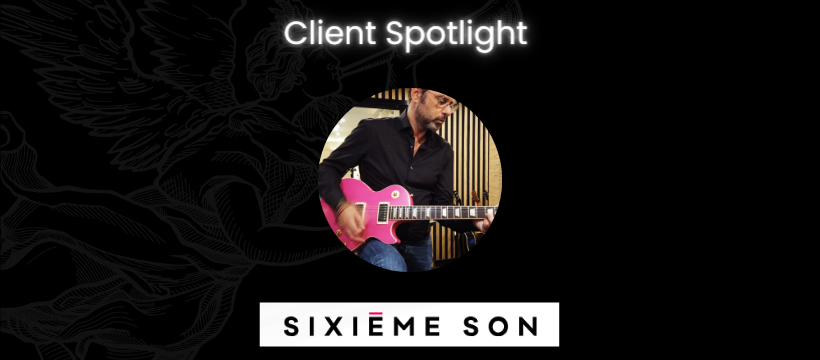A sonic identity is a brand’s secret weapon, one that more and more brands should consider implementing. Suzanne Moccia, VP at Carabiner, sat down with Michael Boumendil, the world’s foremost expert on sonic branding and founder and CEO of Sixième Son.
Combining his talents as a musician, composer, and brand strategist, Michael guides clients in creating sonic identities. He was recently knighted by the French Prime Minister, and given “Chevalier des Arts et des Lettres” for his contributions to music and the arts in France.
In case you haven’t heard, a sonic identity helps brands stand out in a crowded field; it drives brand recall like nobody’s business, gives a new perspective on the brand’s legacy, and solves specific and stubborn brand challenges.
Suzanne: Let’s start with the basics. What is a sonic identity?
Michael: Think of it as the essence of a brand translated into sound. It’s using a set of auditory elements to enable brands to distinguish themselves within the market, telling potential customers that a brand is worthy of their attention because it is unique and special.
It’s more than a jingle because it conveys your brand DNA in many scenarios, cultures, and platforms. A brand’s sonic identity and musical ecosystem can adapt to all touchpoints: advertising, corporate events, product videos, on-hold music, podcasts, social, and retail, ensuring sonic effectiveness across all touchpoints.
Every brand interaction is an opportunity to build or cement loyalty. Deploying an “earprint” for your brand is incredibly effective at capturing those opportunities. And in today’s digital world, if you can’t be heard, you’re invisible.
Suzanne: What can sound communicate about a brand?
Michael: A great deal of things, actually. At their core, sonic identities define the experience of a brand. For instance, we created a sonic identity for TD Bank, a brand that wanted to communicate to customers that it’s not just another staid financial services company. TD Bank wanted customers to consider them a local shop where everyone knows their name.
To do that, we created a sonic identity that features a composition suggesting a stroll through a familiar neighborhood. It has a glockenspiel melody that sounds like the door chime that local shops use.
Another noteworthy example is the outdoor footwear brand Merrell. They wanted to adjust the positioning of the brand to give it a fashion component without losing its heritage as an outdoor brand.
We started by trading music tracks with Merrell’s creative team to help clarify their conception of a fashion sound – a sound that conveyed joy in the outdoors but also had a trendier vibe that could work in a fashion show. After some back and forth, we established a shared vision. We then created a library of sounds that always contain the core elements of the sonic identity but can be turned into more trendy and danceable music. This gave Merrell the freedom to emphasize the fashion aspect of the brand.
Suzanne: How can a sonic identity solve specific brand challenges?
Michael: Sparkling Ice is a brand that sells flavored seltzer water, and it competes in one of the most crowded sectors of the food and beverage sector. The brand engaged us because they needed to resolve some persistent challenges, beginning with name recognition. Consumers thought the product name was “Ice” instead of “Sparkling Ice.”
But the word “ice” isn’t an apt description of the actual product, which is sparkling water in innovative and cool flavors (think kiwi-lemonade or strawberry-watermelon).
We created a lively, fizzy sonic logo that locks the words “Sparkling” and “Ice” together using one note for both words. We have also designed several upbeat and fresh adaptations to match the wide range of products. Problem solved!
Suzanne: What industries have found sonic branding to be useful?
Michael: All brands, including B2B ones, are learning that a sonic identity is just as important to their brands as their visual assets to stand out and forge deeper bonds with their customers. Sixième Son has created nearly 500 sound identities for start-ups, multinationals, associations, and public authorities – from the 2023 Rugby World Cup, Lux, and TaxAct to Sanofi and McKinsey & Company.
Suzanne: That makes sense. What prompted McKinsey to create a sonic identity?
Michael: They undertook a rebranding exercise in 2019 because the brand wanted to enhance its leadership and innovative capacities. Specifically, they wanted their brand identity to emphasize a stronger sense of heritage as well as a culture of transformation.
We created a sonic identity that achieves these goals. It begins with a very specific piano melody unfolding the logo. We wanted to leverage the sound of classical music to instill a sense of heritage. But McKinsey is also innovative, so the music quickly transforms into a complex harmonic development that leads to a simple landing.
It not only conveys a strong sense of innovation, it helps express the leading approach of McKinsey and its dedication to finding solutions. The treatment demonstrates the way a sonic identity can use sounds to communicate sophisticated ideas.
Suzanne: Didn’t you also leverage classical music for Sanofi?
Michael: Yes! Sanofi wanted to convey its one calling: to “pursue the miracles of science to improve people’s lives.” We created a sonic identity called Miracle Dots, inspired by Chopin’s Études and the inner workings of our brains. The left hemisphere is home to logic, rigor, language, and the ability to read, write, and count. The right hemisphere is the realm of creativity, imagination, emotion, and empathy. The musical piece is an ode to science. It combines musical substance and technical challenge to form a complete and unique artistic work.
Suzanne: Where can our readers hear some of the great work you’ve created?
Michael: We have case studies of some of our clients on our website. I invite everyone to explore the power of sonic identity.
Suzanne: I certainly encourage all readers to explore them. Thank you for speaking to us today.
Michael: Je vous en prie!

